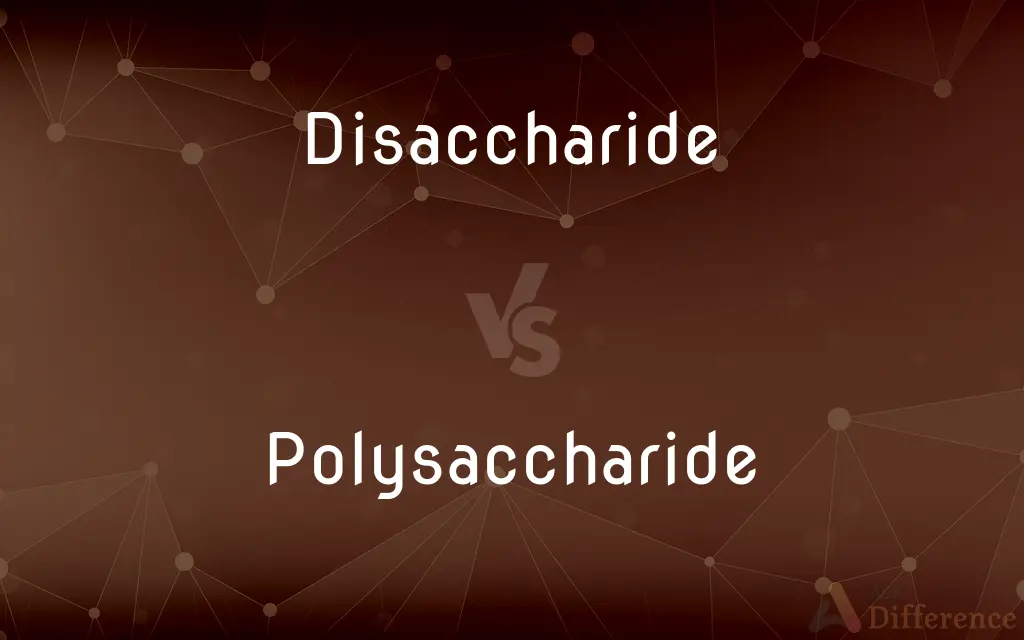Disaccharide vs. Polysaccharide — What's the Difference?
By Urooj Arif & Fiza Rafique — Updated on March 24, 2024
Disaccharides are sugars formed from two monosaccharides, whereas polysaccharides consist of many monosaccharide units.

Difference Between Disaccharide and Polysaccharide
Table of Contents
ADVERTISEMENT
Key Differences
Disaccharides, like sucrose and lactose, are simple sugars composed of two monosaccharide molecules joined together. They are soluble in water and sweet-tasting. On the other hand, polysaccharides are complex carbohydrates, including starch and cellulose, formed by the polymerization of many monosaccharide units. These are not sweet and are less soluble in water.
While disaccharides are quickly digested and absorbed, providing immediate energy, polysaccharides are digested more slowly, offering a sustained energy release. This is because polysaccharides often have a more complex structure that takes longer for the digestive system to break down.
Disaccharides play a key role in the diet as a source of quick energy and are found in foods like table sugar and dairy. Polysaccharides, however, serve as major energy storage forms (like glycogen in animals) and structural components (such as cellulose in plants).
In terms of health impact, excessive consumption of disaccharides can lead to health issues like obesity and diabetes due to their rapid absorption and conversion to glucose. Polysaccharides, with their complex structure, contribute to dietary fiber, promoting digestive health and reducing the risk of chronic diseases.
The body metabolizes disaccharides and polysaccharides differently. Enzymes in the digestive tract break down disaccharides into monosaccharides before absorption. Polysaccharides require a more extensive breakdown process, involving various enzymes, to be converted into monosaccharides for absorption.
ADVERTISEMENT
Comparison Chart
Composition
Two monosaccharide units
Many monosaccharide units
Solubility
Generally soluble in water
Less soluble in water
Taste
Sweet
Not sweet
Digestion and Absorption
Quickly digested and absorbed
Slowly digested and absorbed
Role
Quick energy source
Energy storage and structural roles
Compare with Definitions
Disaccharide
A carbohydrate composed of two monosaccharide units.
Sucrose (table sugar) is a disaccharide made from glucose and fructose.
Polysaccharide
Important for long-term energy storage and structural integrity.
Glycogen, stored in liver and muscle cells, is a polysaccharide.
Disaccharide
Found in nature and commonly used in food.
Lactose is the disaccharide found in milk and dairy products.
Polysaccharide
Can be both digestible and indigestible by humans.
Humans can digest starch but not cellulose.
Disaccharide
Can be broken down into monosaccharides by hydrolysis.
During digestion, sucrose is broken down into glucose and fructose.
Polysaccharide
A complex carbohydrate consisting of a large number of monosaccharide units.
Starch is a polysaccharide used by plants to store energy.
Disaccharide
Provides quick energy upon consumption.
Sports drinks often contain disaccharides for rapid energy.
Polysaccharide
Not sweet and forms structural components in cells.
Cellulose gives plant walls their rigidity.
Disaccharide
Implicated in dental health issues when consumed excessively.
High intake of sucrose can lead to tooth decay.
Polysaccharide
Contributes to dietary fiber, beneficial for digestive health.
Eating foods high in polysaccharides, like vegetables, can help maintain a healthy gut.
Disaccharide
A disaccharide (also called a double sugar or biose) is the sugar formed when two monosaccharides are joined by glycosidic linkage. Like monosaccharides, disaccharides are simple sugars soluble in water.
Polysaccharide
Polysaccharides (), or polycarbohydrates, are the most abundant carbohydrate found in food. They are long chain polymeric carbohydrates composed of monosaccharide units bound together by glycosidic linkages.
Disaccharide
Any of a class of sugars, including lactose and sucrose, that are composed of two monosaccharides.
Polysaccharide
A carbohydrate (e.g. starch, cellulose, or glycogen) whose molecules consist of a number of sugar molecules bonded together.
Disaccharide
(carbohydrate) Any sugar, such as sucrose, maltose and lactose, consisting of two monosaccharides combined together.
Polysaccharide
Any of a class of carbohydrates, such as starch and cellulose, consisting of a number of monosaccharides joined by glycosidic bonds.
Disaccharide
Any of a variety of carbohydrates that yield two monosaccharide molecules on complete hydrolysis
Polysaccharide
(carbohydrate) A polymer made of many saccharide units linked by glycosidic bonds.
Cellulose, starches, and complex carbohydrates, such as glycogen, are common polysaccharides in biology.
Polysaccharide
Any of a class of carbohydrates whose molecules contain chains of monosaccharide molecules
Common Curiosities
How do disaccharides and polysaccharides differ in taste?
Disaccharides are sweet-tasting, while polysaccharides are generally not sweet.
How do the roles of disaccharides and polysaccharides differ in the body?
Disaccharides provide quick energy, whereas polysaccharides serve as energy storage and structural components.
What are disaccharides?
Disaccharides are carbohydrates made up of two monosaccharide units, such as sucrose and lactose.
Can eating too many disaccharides be harmful?
Yes, excessive consumption of disaccharides can lead to obesity, diabetes, and dental issues.
What are polysaccharides?
Polysaccharides are complex carbohydrates formed from long chains of monosaccharide units, including starch and cellulose.
Which is more soluble in water, disaccharides or polysaccharides?
Disaccharides are more soluble in water than polysaccharides.
Are polysaccharides important for health?
Yes, they contribute to dietary fiber, promoting digestive health and reducing chronic disease risk.
Are all polysaccharides digestible by humans?
No, humans can digest some polysaccharides like starch, but not others like cellulose.
What is a common source of disaccharides in the diet?
Common sources include table sugar and dairy products.
How do polysaccharides contribute to plant structure?
Cellulose, a polysaccharide, gives plant walls their rigidity.
How are disaccharides digested?
They are broken down into monosaccharides by enzymes in the digestive system before absorption.
Why is glycogen considered a polysaccharide?
Glycogen is made up of many glucose units, serving as a primary form of energy storage in animals.
Can polysaccharides be used as a dietary fiber?
Yes, indigestible polysaccharides contribute to dietary fiber, aiding in digestion and health.
Why are polysaccharides not sweet?
Their large and complex structure does not activate taste receptors that perceive sweetness.
Share Your Discovery

Previous Comparison
Sector vs. Vector
Next Comparison
Xylene vs. AcetoneAuthor Spotlight
Written by
Urooj ArifUrooj is a skilled content writer at Ask Difference, known for her exceptional ability to simplify complex topics into engaging and informative content. With a passion for research and a flair for clear, concise writing, she consistently delivers articles that resonate with our diverse audience.
Co-written by
Fiza RafiqueFiza Rafique is a skilled content writer at AskDifference.com, where she meticulously refines and enhances written pieces. Drawing from her vast editorial expertise, Fiza ensures clarity, accuracy, and precision in every article. Passionate about language, she continually seeks to elevate the quality of content for readers worldwide.














































